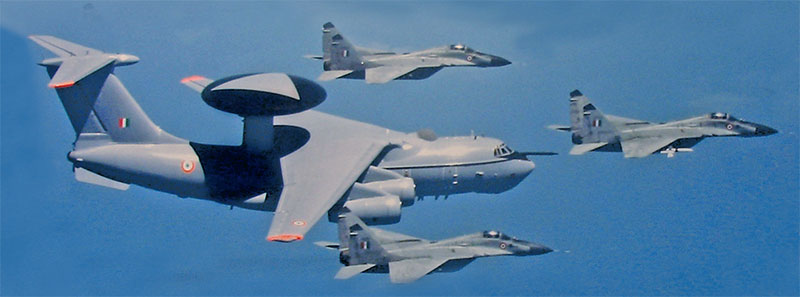Key takeaways from IAF-PAF’s February 27 aerial engagement
Prasun K. Sengupta
South Asia’s first aerial engagement in 48 years, which took place on the morning of February 27 this year, was noteworthy for two reasons. Firstly, the engagements between the two opposing air forces saw the successful usage of both beyond-visual-range air-to-air missiles (BVRAAM) and short-range air-to-air missiles (SRAAM), with the former being a first for the skies of South Asia. Secondly, both opposing air forces engaged one another not only with their respective multi-role combat aircraft (MRCA) fleets, but also with combat-support platforms like airborne early warning & control (AEW&CS) aircraft — the world’s first-ever such engagement in the history of aerial warfare. And it is in these two areas that witnessed outcomes that were not entirely surprising when analysed in detail, and which will have a profound impact on both future force modernisation projects of both air forces, but also on the employment of offensive airpower in the next round of limited hostilities in South Asia.

In the arena of air combat with BVRAAMs, the Indian Air Force (IAF) had an appreciable head-start over the Pakistan Air Force (PAF) when in the Eighties it had procured Vympel R-23R and Matra Super 530D missiles along with its MiG-23MF and Mirage-2000H/TH combat aircraft, whereas the PAF could procure its first BVRAAMs — the Raytheon-built AIM-120C-5 AMRAAMs — only in the previous decade. Consequently, the IAF was expected to have acquired a degree of proficiency in putting its present holdings of BVRAAMs to good use by applying innovative tactics.
But surprisingly, this did not turn out to be the case, with the PAF ending up scoring the first air combat kill with a BVRAAM. On the other hand, the IAF’s successful employment of the Vympel R-73E SRAAM with the help of the Sura-1 helmet-mounted display system (HMDS) once again proved that even third-generation legacy-MRCAs — when suitably upgraded — can be lethal tools in the hands of experienced air warriors. But if the ‘deep upgrade’ efforts are half-hearted, then a heavy price will have to be paid, which is exactly what the IAF seems to have now discovered.
Take, for instance, the MiG-21 Bison upgrade project, which in the late Nineties was meant to give a new lease of life to 125 of the IAF’s 225 of those MiG-21 Bis light-MRCAs that were scheduled to be phased out on the expiry of their total technical service-life - TTSL of 20 years/2,400 flight-hours. Known as the MiG-21-93 project, it involved the following: extending the TTSL of the airframe and its Tumansky R-25-300 turbofan (producing 97.1kN thrust with afterburning) for up to 40 years and 4,000 flying hours; installing the Phazotron NIIR-developed Kopyo (Spear) multi-mode airborne pulse-Doppler X-band radar, and a new navigation-and-attack system developed by THALES of France that included a TOTEM ring laser gyro-based inertial navigation system (RLG-INS) coupled to a NSS-100P GPS receiver, ELBIT/El-Op Type 967 heads-up display, a MFD-55 active-matrix liquid-crystal display (AMLCD), locally-developed Tarang Mk.1 radar warning receiver (RWR), radar altimeter, hands-on-throttle and stick (HOTAS) controls, digital flight data recorder, autopilot, and a stores management system.
The entire project was co-developed by RAC MiG, Phazotron-NIIR, GosNIIAS and Sokol Joint-Stock Company. Thus, the MiG-21 Bison was made capable of airborne target detection and lock-on range both in look-up and look-down while using R-27R and R-77/RVV-AE BVRAAMs; ground and sea-surface target detection and improved communications and navigation aids; airborne target detection and engagement range in action in the front hemisphere; improved PGM guidance and engagement capabilities in action against ground targets of any type; track-while-scan mode with the capability of tracking up to 10 targets and engaging two of them concurrently; and self-protection through the usage of the ELTA Systems-built EL/L-8222 high-band self-protection pod, plus newly-installed chaff/flare countermeasures dispensers. And yet, on the morning of February 27, one such MiG-21 Bison (armed with two Vympel R-77/RVV-AE BVRAAMs and two R-73E SRAAMs) of the IAF’s 1 Wing’s No.51 ‘Sword Arms’ Sqn operating out of Avantipora air base in Jammu & Kashmir (J & K) was lost to enemy fire. So what went wrong?
Lessons from the ‘Furball’
At around 9:30am on February 27, the IAF flight controllers noticed a large package of 24 PAF combat aircraft taking off in a matter of 15 minutes from three different air bases. These included at least 12 F-16C/Ds. As they approached the Line of Control (LC), they split up into two different formations, with airborne battle management cues being provided by a Saab 2000 AEW&CS platform. The formations included four Mirage-VPAs, four Mirage-IIIEAs and four JF-17s headed for the Sundarbani-Rajouri-Naushera sub-sectors; and eight F-16s headed for the Rajouri-Mendhar sub-sector and Nangi Tekri in Karmara.
Pitted against them were two of the IAF’s upgraded Mirage-2000INs and four MiG-21 Bisons flying north of the Pir Panjal Range, and four Su-30MKIs to the south of the Range. The main PAF strike force comprised four F-16C/Ds armed with 12 DENEL Dynamics-supplied Raptor-IID TV-guided gliding munition, while the remaining four F-16C/Ds and four JF-17s were tasked with the protection of the strike package while remaining in a rear area over the Mangla Dam near the Pakistan Occupied Kashmir (PoK)-Pakistan Punjab border. Targets selected by the PAF for the air-strikes were the Indian Army posts at Bhimber Gali (elevation of 5,479 feet), Krishna Ghati Top (Nangi Tekri) at a height of 4,665 feet, Potha at an elevation of 4,073 feet, and an ammunition storage area in Narian (belonging to the 25 Infantry Division of the Indian Army) at an elevation of 2,000 feet. These targets, falling in India’s Rajouri sector, were deliberately selected for the sake of establishing Pakistan’s ‘moral ascendancy’ along this portion of the LC — given the fact that it is from these areas that the Indian Army dominates its opposing adversary’s Battal sector, which is located at lower altitudes.
You must be logged in to view this content.

